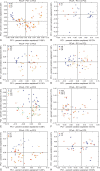Characteristics of fecal and mucosa-associated microbiota in Chinese patients with inflammatory bowel disease
- PMID: 25121355
- PMCID: PMC4602441
- DOI: 10.1097/MD.0000000000000051
Characteristics of fecal and mucosa-associated microbiota in Chinese patients with inflammatory bowel disease
Abstract
The intestinal microbiota plays an important role in the pathogenesis of inflammatory bowel disease (IBD), and geographical and genetic backgrounds impact the composition of the intestinal microbiota. However, there is a lack of evidence regarding the overall changes and characteristics of fecal-associated microbiota (FAM) and mucosa-associated microbiota (MAM) in Chinese patients with IBD. We recruited 26 patients with Crohn's disease (CD), 46 patients with ulcerative colitis (UC), and 21 healthy individuals; we collected matched fresh fecal and mucosal samples from the same subjects. The microbial communities were studied by 454-pyrosequencing. Community-wide changes in FAM and MAM were observed in patients with IBD. The proportion of several butyrate-producing bacteria, such as of the genera Roseburia, Coprococcus, and Ruminococcus were significantly reduced, whereas the pathogens Escherichia-Shigella and Enterococcus were prevalent in patients with IBD. FAM and MAM were similar between CD and UC. FAM differed from MAM in healthy individuals and patients with UC. In conclusion, the compositions of FAM and MAM were altered in patients with IBD. The reduction of butyrate-producing bacteria and the increase in opportunistic pathogens might be associated with the pathogenesis of IBD.
Conflict of interest statement
The authors have no conflicts of interest to disclose.
Figures



References
-
- Molodecky NA, Soon IS, Rabi DM, et al. Increasing incidence and prevalence of the inflammatory bowel disease with time, based on systematic review. Gastroenterology. 2012;142:46–54. - PubMed
-
- Jiang L, Xia B, Li J, et al. Retrospective survey of 452 patients with inflammatory bowel disease in Wuhan City, Central China. Inflamm Bowel Dis. 2006;12:212–217. - PubMed
-
- Chassaing B, Darfeuille-Michaud A. The commensal microbiota and enteropathogens in the pathogenesis of inflammatory bowel disease. Gastroenterology. 2011;140:1720–1728. - PubMed
-
- Rutgeerts P, Gobes K, Peeters M, et al. Effect of faecal stream diversion on recurrence of Crohn’s disease in the neoterminal ileum. Lancet. 1991;338:771–774. - PubMed
-
- D’Haens GR, Geboes K, Peeters M, et al. Early lesions of recurrent Crohn’s disease caused by infusion of intestinal contents in excluded ileum. Gastroenterology. 1998;114:262–267. - PubMed
Publication types
MeSH terms
Substances
LinkOut - more resources
Full Text Sources
Other Literature Sources
Medical

